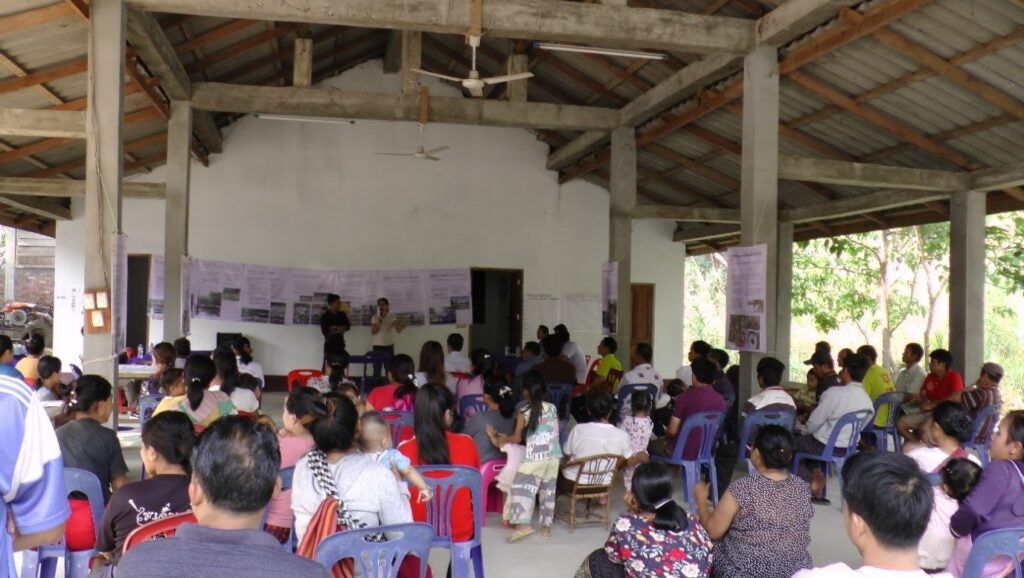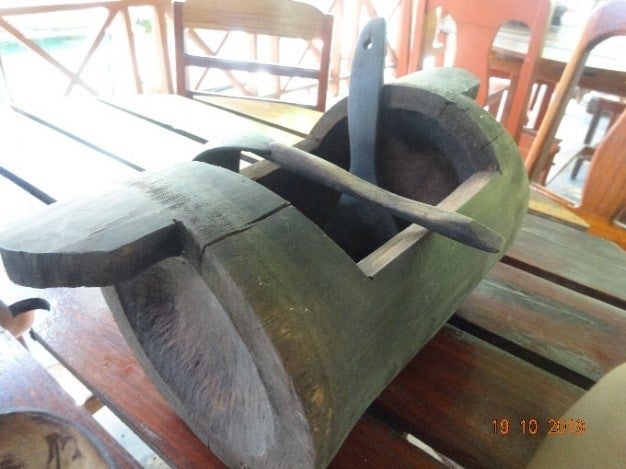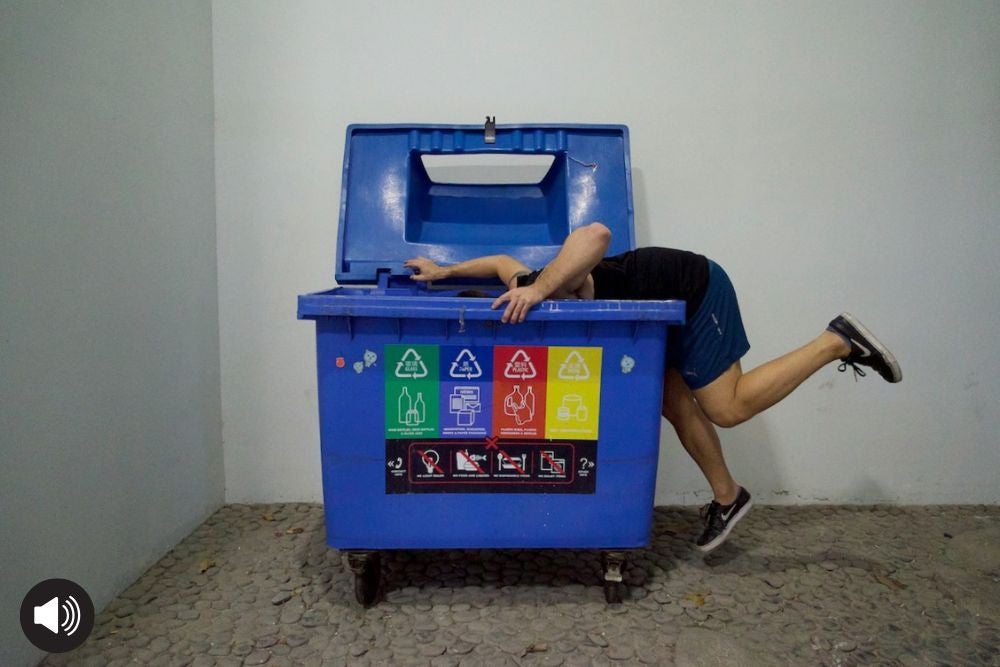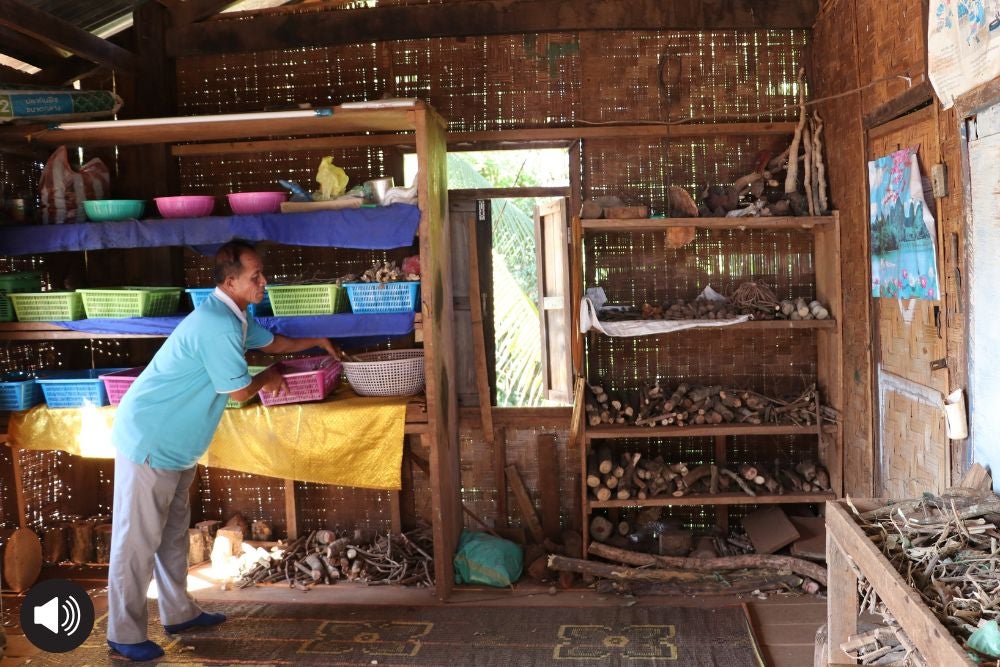Waste Management and Rural Tourism at Thapene Village and the Kuang Si Waterfall Park in Laos
https://doi.org/10.25542/g0vz-e815
Tourism is often a double-edged sword in the rural villages of less-developed countries which typically lack suitable waste management infrastructure. While tourism provides a source of income, it also exacerbates the problem of waste management which can tarnish the natural beauty that makes these villages attractive to visitors in the first place. This has been observed in rural tourism sites from Vietnam, China, to Romania. In particular, the non-biodegradability of plastic waste means it accumulates in the environment if not properly incinerated, potentially harming animals and reducing agricultural productivity. If incinerated without using a proper incinerator and a smoke-scrubber, plastic releases harmful dioxins that can cause cancer and birth defects in humans.
Home to the Kuang Si Waterfall, a famous tourist destination in northern Laos, Thapene Village hosted an average of about 230,000 visitors per year between 2013 and 2017. Waste management, however, had been an issue. A village elder shared:
When the government staff come to inspect each village, if the village is clean enough, the government will give a certificate [“ບ້ານສາມສະອາດ, bansamsaat” or “Clean Village”]. They [came some time ago] to say that Thapene Village could be [certified] a clean village, but then I wonder: “How come? Actually the village is not very clean nor [are the waterways] clean.” (Translated interview transcript, May 2020)
Government officials who recently visited the village shared the same sentiment. According to the village leader, these officials had seen litter accumulated in a stream and asked the village to improve its cleanliness. While some villagers believed that the lack of cleanliness was caused by fellow villagers, others believed that tourism activities were responsible. To better understand the waste management situation and propose recommendations, we conducted participatory research from May 2019 to March 2020. Our methods included participant-observation, interviews, qualitative site observations and a quantitative assessment of the amount of rubbish produced.
Kuang Si Waterfall Park, Thapene Village
The Kuang Si Waterfall Park is located in Thapene Village, about 30 km south of the UNESCO World Heritage Town of Luang Prabang city (Map 1). It is the most-visited destination in the province of Luang Prabang, attracting both domestic and international tourists. Most tourists visit the Waterfall Park as a day trip from Luang Prabang city, although a few guesthouses operate for overnight stays. By supporting tourism-related services, the mainly Khmu and Lao villagers of Thapene Village have been able to generate income in addition to agriculture since the establishment of the Kuang Si National Park in the 1980s.

Waste Management and Tourism
Thapene Village started a rubbish collection system in the 2000s with the building of two dumpsites supported by the Luang Prabang Tourism Department. A rubbish collection truck collected rubbish from houses, shops, restaurants, guesthouses, and the Kuang Si Waterfall Park. The collected rubbish sent to the dumpsite and burnt about once a week, or whenever was full.
About 600–1000 kg of rubbish per day was produced and sent to the dumpsite. Of this rubbish, 15–35 per cent was from households and 65–85 per cent was generated by tourism-related services/activities. At Kuang Si Waterfall Park, each visitor generated about 0.14 kg of rubbish (comparable to every two visitors leaving behind a full 300ml bottle of water to be cleared from the park). Tourism substantially increased the number of items that cannot be easily incinerated. For example, coconut husks (from coconut drinks) took a long time to burn due to their high moisture content, while glass beer bottles are not burnable and ended up accumulating in the dumpsite.

There was an informal recycling economy, where some villagers collected used metal cans and plastic bottles to sell to collectors for US$0.35/kg and US$0.10/kg respectively. Due to the low selling price, used plastic bottle collection was unattractive and many were still sent to the dumpsite.
Our qualitative observations of the rubbish collected revealed that there was more food-related organic waste in the rubbish from households, whereas there were more single-use plastics (e.g., plastic bottles, styrofoam plates/boxes, plastic straws, plastic bags) in the rubbish from tourism-related services, activities and sites. This suggests that tourism-related activities, rather than household activities, are a larger producer of non-biodegradable, single-use plastic waste openly burnt in the dumpsite. Businesses and households do not separate their waste into organic and inorganic waste for composting. This increases the overall amount of rubbish going to the dumpsite, while missing the opportunity to turn organic waste into soil fertilizers.

While tourism has helped to improve livelihoods in Thapene Village, it has also accelerated the adoption of single-use plastics, originally introduced for tourists’ convenience. The use of styrofoam boxes for food, plastic straws, and plastic cups became prevalent around 2010 and single-use chopsticks wrapped in plastic around 2015.
We observed plastic litter in both residential and tourism zones in the village. Some were incidental, having fallen out of the open-top rubbish collection truck during transportation, windblown out of rubbish bins, or rummaged out of bins by dogs. However, some were intentional and linked to tourism-related activities. Next to a carpark where drivers waited for their guests, we encountered a ditch filled with plastic bottles. Locals admitted that while some villagers had the habit of littering, domestic tourists and idling drivers (who were waiting for tourists) tended to litter there too.
Ways of improving waste management
To address the prevailing problem of plastic pollution, we combined our understanding of the waste management situation in Thapene Village and best practices from other rural tourism sites to develop a set of recommendations. These were presented on 12 March 2020 at an exhibition-cum-workshop in the village, which was organised in collaboration with village leaders.

Reusing and reducing single-use plastics
Given that 40 per cent of plastic waste around the world is single use, reusing plastic can help significantly decrease the amount of single-use plastic waste produced in the first place. As villagers tend to buy items in small quantities due to their limited financial liquidity, shops would cater to their consumption patterns by repacking oil and rice into small plastic bags. However, some villagers are becoming more affluent. Environmental and community development organisations could introduce public education on reducing the use of single-use plastics, so that villagers would choose to buy oil, shampoo and other daily necessities in larger quantities . Businesses could provide water refill stations instead of single-use plastic water bottles to their guests/customers and provide plastic bags and plastic straws only when people ask for them.
Use biodegradable alternatives to plastic
Traditional and local practices may provide biodegradable alternatives to single-use plastic. Many village elders in Thapene Village used bamboo baskets as carrier bags for their shopping. The villagers also recognised the usefulness and advantages of traditional materials, such as banana leaves to package food and gourd bottles to store water. For example, gourd bottles keep water cool, while a certain variety of banana leaves makes steamed food fragrant. In Lachung, a mountain village and rural tourism site in Sikkim, India, bamboo is used as an alternative to plastic bottles and plastic containers, and composted after use to enrich the soil rather than sent to a dumpsite.

The use of these traditional materials in local practice may add a distinctive character to rural tourism sites and can make these sites more attractive to tourists. In Thapene Village, village elders are skilled in making handicrafts from biodegradable materials such as bamboo, wood, and coconut husks. For example, cutlery could be crafted from bamboo and used as alternatives to single-use plastic cutlery. Such skills should continue to be nurtured.
Commercial single-use biodegradable packaging (e.g., boxes made from palm leaves) is another alternative, but its adoption needs to be incentivised by subsidies. For example, 100 pieces of styrofoam boxes could be purchased for 50,000 LAK (about US$6). On the other hand, one 15-cm wide disposable bamboo plate produced by the company Nahm Dong Park in Luang Prabang costs around 900 LAK (about US$0.10), almost twice the cost of one styrofoam box. Subsidies could come from grants that aim to promote sustainable tourism. An example is the SWITCH-Asia Grants Programme, which funds the Luang Prabang Handle With Care project.
Restrict the inflows of non-biodegradable materials
Plastic materials, mainly from goods and materials meant for villagers’ activities, tend to flow into Thapene Village from other towns or the city. For example, convenience stores that line the village’s main road are stocked with plastic-packaged goods from the city.

In Lachung, the villagers passed a law to ban single-use plastics in 2016. Tourists are informed about the no-plastic rule 25 km before entering the village, and a fine of US$70 is imposed on anyone who insists on bringing in disposable plastic bottles. The ban has been successfully implemented with the strong support of the villagers who believe in keeping their environment clean. A similar move to restrict the inflows of plastic materials could be considered at Thapene Village.
Invest in a suitable waste management infrastructure
Most of the material waste ends up in the village dumpsite, and outflow of material waste is negligible. Hence an improved waste management infrastructure is still needed. Investing in small-scale waste incinerators is one option, as implemented in 2019 by an outdoor adventure company for villages in Gopeng, Malaysia. Fitted with a scrubber, this small-scale incinerator can help reduce total amount of trash while ensuring the emitted smoke is non-toxic.
Collaborating with tourism companies to facilitate the outflow of waste materials
Another measure is to make it mandatory for tourists or tour companies to bring non-biodegradable waste back to the city where municipal waste disposal infrastructure is available. This is especially suitable for rural tourism sites that do not receive a large number of tourists. For example, Nong Khuay Village, a village in the upper watershed area of the Kuang Si Waterfall, regularly hosts homestays for small groups of tourists on guided treks or volunteer tourism. This measure would be part of corporate social responsibility and in the spirit of “Take only photos, leave only footprints”.
Conclusions
The exhibition-cum-workshop was well-attended by the villagers (more than the 60 per cent expected by the village leader), and many felt that it was informative. One villager shared that they understood waste management better while another felt that the scale of the rubbish problem was presented to them very clearly. Even though the village leader felt that change could only be implemented “little by little”, the general feeling was positive, with one village elder stating that it was a good start for raising awareness about the non-biodegradability of plastic and the harmful health effects from burning plastic. During the workshop, the village leaders also had the opportunity to discuss their challenges with representatives from the Luang Prabang Urban Development & Administration Authority (UDAA). This led to the government staff providing the village with a closed-top rubbish collection truck and a restructuring of the village waste collection system.
Our participatory research showed that tourism activities has exacerbated the challenge of waste management at Thapene Village. Other rural tourism sites face the same problem as these areas lack the municipal waste management infrastructure of cities but have continuous inflow of materials for tourists and villagers. A multi-pronged approach for waste minimisation and management is needed. This includes behavioural change, i.e., choosing alternatives to single-use plastics in daily life, economic change, i.e., restricting the inflows of non-biodegradable materials, and structural change, i.e., improving the waste management system and infrastructure.
Globally, the problem of waste management reflects human’s exploitation of nature. This is complicated by the presence of plastics in the waste stream: while plastic makes our lives more convenient, it is also very difficult to manage as rubbish. However, it is the beauty of nature in rural tourism sites that makes them attractive to visitors. Therefore, it is imperative for the tourism sector to engage more vigorously in environmental efforts that sustain this natural beauty.
The views expressed in this forum are those of the individual authors and do not represent the views of the Asia Research Institute, National University of Singapore, or the institutions to which the authors are attached.
Dr Yingshan Lau is a Research Fellow working on the project ‘Climate Governance of Nature-based Carbon Sinks in Southeast Asia’, with a focus on forests. She is curious about nature-society interactions and is passionate about traditional ecological knowledge, forests, water, agriculture and sustainable rural development in Southeast Asia. Previously, Dr Lau worked for PUB, Singapore’s National Water Agency, taking on the portfolios of master planning for the Active, Beautiful, Clean Waters (ABC Waters) Programme, community relations, and a secondment at the Centre for Liveable Cities.










